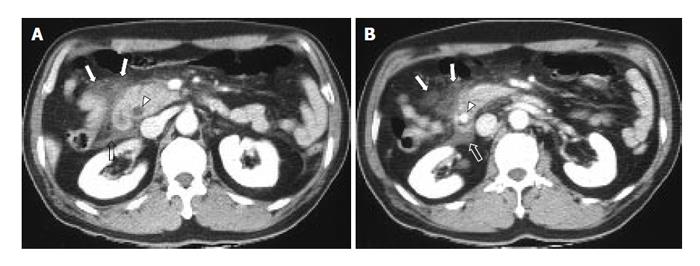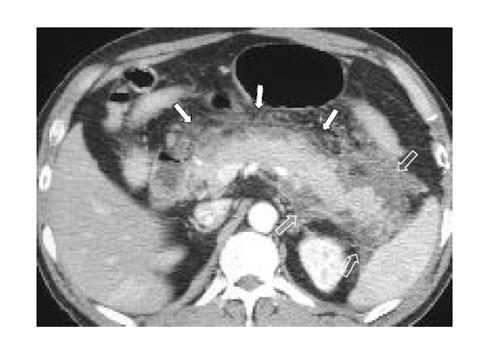Copyright
©2006 Baishideng Publishing Group Co.
World J Gastroenterol. Jul 28, 2006; 12(28): 4524-4528
Published online Jul 28, 2006. doi: 10.3748/wjg.v12.i28.4524
Published online Jul 28, 2006. doi: 10.3748/wjg.v12.i28.4524
Figure 1 Peripancreatic infiltration scores (1-3).
A: Score 1 (Irregular peripancreatic infiltration without fluid collection). CT showing irregular strands of peripancreatic fat infiltrations in the compartment of RP (arrow), LP (open arrows), and LSR (arrowhead); B: Score 2 (Peripancreatic fluid collection with no or equivocal degree of mass effect). CT showing multiple fluid collections without mass effect in the compartment of RSR (arrows) and LSR (open arrows). Score 1 infiltrations in the compartment of RP and LP (arrowheads) are also seen; C: Score 3 (Peripancreatic fluid collection with definite mass effect to adjacent organs). CT showing score 3 fluid collection in the LP and LSR compartments (arrows) displacing or compressing adjacent bowels.
Figure 2 A 61-year old man with a clinical diagnosis of gallstone pancreatitis due to distal common bile duct stone.
A and B: CT scans showing the peripancreatic infiltration or fluid collection predominantly in the right abdomen: score 1 infiltration in RP compartment (arrows), score 2 fluid collection in RSR compartment (open arrows). Distal common bile duct stone with bile duct dilatation also can be seen (arrowheads).
Figure 3 A 57-year old woman with score 1 infiltration in the RP and LP compartments (arrows) and score 2 fluid collections in the LP and LSR compartments (open arrows) is turned out to have a clinical diagnosis of alcoholic pancreatitis.
- Citation: Kim YS, Kim Y, Kim SK, Rhim H. Computed tomographic differentiation between alcoholic and gallstone pancreatitis: Significance of distribution of infiltration or fluid collection. World J Gastroenterol 2006; 12(28): 4524-4528
- URL: https://www.wjgnet.com/1007-9327/full/v12/i28/4524.htm
- DOI: https://dx.doi.org/10.3748/wjg.v12.i28.4524















